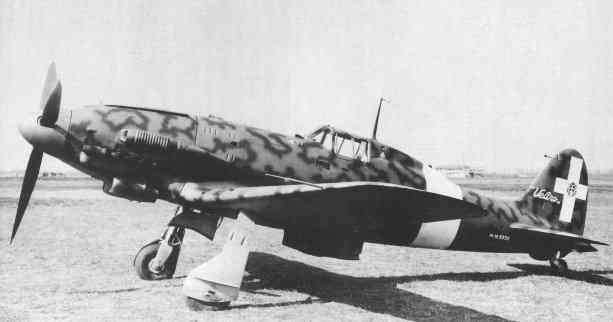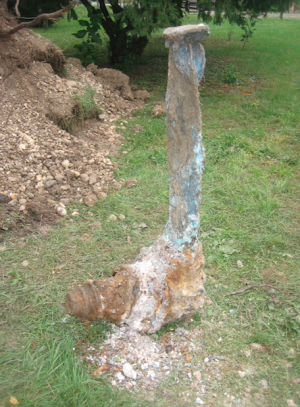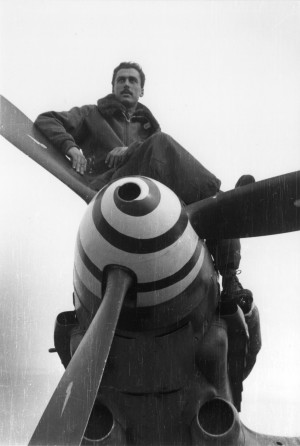

On October 12th, 2013 the members of an Italian aeronautical historical research group called Gruppo Ricerche Storiche Aeronautiche (GRSA) recovered the remains of a Macchi C.205 Veltro piloted by Sgt.Maj. Angelo Zaccaria who crashed with his aircraft on March 18th, 1944 near Fiume Veneto (PN). Ms. Danila Trevisan, owner of the land where the aircraft crashed, gave her permission for the recovery, as did the municipal and local authorities.
GRSA funded the recovery privately, and undertook their mission with both sensitivity for the lost pilot’s family, and a desire to tell his story alongside the other Italian airmen in the skies of Friuli. The association’s goal is to study and research events and topics relating to the Italian Air Force in the Friuli-Venezia Giulia region of Italy, without reference to a particular historical period. Currently GRSA collaborates in various cultural activities. Its most noted project so far was the October 2007 recovery of WWII Luftwaffe pilot Kurt Niederhagen’s remains and his Messerschmitt Bf.109 G-6 shot down on January 30th, 1944 in the countryside of Concordia Sagittaria (Venice).
 The inhabitants and aviation enthusiasts of the area have known about this aircraft for many years, and the crash records were available in the city’s archives. GRSA only needed to survey the known crash location with metal detectors, and raise funds to rent the specialized equipment required to dig the land. Unfortunately, due to the violence of the aircraft’s impact during the crash, only a few parts of the Macchi remained at the site. The most recognizable parts recovered were a few valves from the DB-605 engine and one of the three Piaggio propeller blades.
The inhabitants and aviation enthusiasts of the area have known about this aircraft for many years, and the crash records were available in the city’s archives. GRSA only needed to survey the known crash location with metal detectors, and raise funds to rent the specialized equipment required to dig the land. Unfortunately, due to the violence of the aircraft’s impact during the crash, only a few parts of the Macchi remained at the site. The most recognizable parts recovered were a few valves from the DB-605 engine and one of the three Piaggio propeller blades.
The Macchi C.205 was a development of the earlier C.202 Folgore. With a top speed of some 400 mph and equipped with a pair of 20mm cannon and 12.7 mm Breda machine guns, the Macchi C.205 Veltro (Italian for Greyhound) was highly respected by Allied and Luftwaffe pilots alike. Regarded as the best Italian fighter aircraft of World War II, it proved to be extremely effective in action against Allied bombers, and capable of successfully clashing on equal terms with such renowned fighters as the North American P-51D Mustang, a capability which encouraged the Luftwaffe to use a number of these aircraft to equip one their own fighter groups.
Major Angelo Zaccaria was one of thirty 1st Fighter Group pilots taking off from Campoformido airport on March 18th, 1944 to intercept a U.S. bombing raid against airports in the Friuli region. It was a large raid, composed of 350 bombers escorted by 126 fighters. Five B-17 Flying Fortresses and two fighters were lost to the Italian fighters with help from their German allies who took off from Maniago and Lavariano airfields.

Despite these victories the Italian ’hunters’ lost three Macchi 205s. The pilots from two of these Veltros, lieutenants Stabile and Cavatore, bailed out safely. Zaccaria was not so lucky. He damage the right engine of a P-38 Lightning flown by Lt. Kob, but another P-38 flown by Lt.Phillips of the 82nd FG hit his Veltro. Zaccaria tried to bail out, but the twenty six year old pilot from Ravenna was mortally wounded during the fight with Lt.Phillips. His body, hanging from a half deployed parachute, hit the ground right in front of the main church in Pescincanna.
Major Zaccaria was buried in his home town of Ravenna.
Angelo Zaccaria was born in Ravenna on April 12, 1917 and obtained his pilot’s license flying the Fiat AS.1 at the Aero Club of Ravenna on January 24, 1938. He joined the Regia Aeronautica (RA) on June 9th of the same year. Appointed Sergeant on June 22nd, he attended the RA’s Flight School in Pescara, then transferred to Orvieto until he joined the Fighter School in Foligno.
On July 4th, 1939 he joined an operational squadron, the 6a Squadriglia del 14° Stormo B.T at Benina field in Libya. He returned to Italy on January 5th, 1941, along with his squadron, and they took up residence at F.Bonazzi airport in Reggio Emilia on March 13th. On 20 April 1941 Zaccaria transferred to the 174th Squadron RST in Ciampino Sud and the returned with his unit to North Africa. On January 11th, 1942 he returned home again and joined Group “C” of the 46th Wing based at Pisa, receiving promotion to Sergeant Major. Following the armistice of September 8th, 1943, Zaccaria decided to join the newly formed Aeronautica Republicana. Angelo Zaccaria received a Silver Medal, a Bronze Medal and a War Cross for Military Valour during his aviation career. He flew several aircraft types including the Fiat AS.1, CR.42 and G.50, the Breda Ba.25, the Caproni Ca.133 and Ca.164, Savoia-Marchetti SM.81 and SM.79, Romeo Ro.41, Reggiane Re.2001 and finally, the Macchi MC.205V.
WarbirdsNews wants thank Roberto Bassi president of Gruppo Ricerche Storiche Aeronautiche for the Italian version of this article.
[inpost_galleria thumb_width=”200″ thumb_height=”200″ post_id=”10818″ thumb_margin_left=”3″ thumb_margin_bottom=”0″ thumb_border_radius=”2″ thumb_shadow=”0 1px 4px rgba(0, 0, 0, 0.2)” id=”” random=”0″ group=”0″ border=”” type=”yoxview” sc_id=”sc1394416220097″]


1 Trackback / Pingback
Graphic Design, Branding and Aviation Art